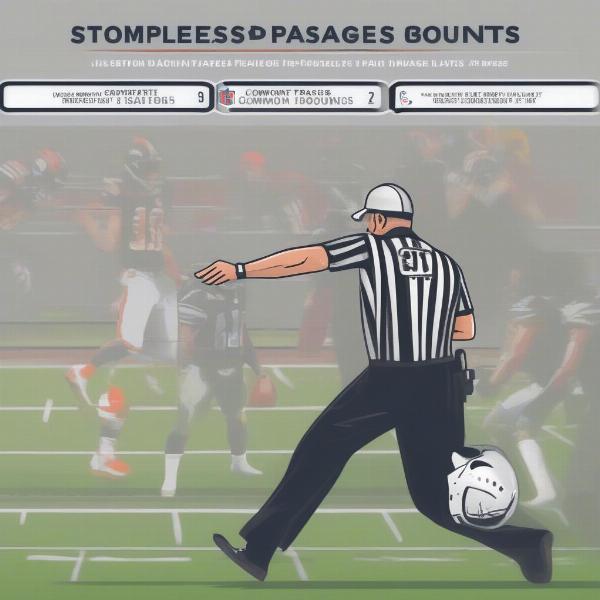How Long Is A Football Game? It’s a question that seems simple, but the answer can be surprisingly complex. From regulation play to overtime, half-time shows, and TV timeouts, several factors influence the overall duration of a football match. Understanding these elements will give you a clearer picture of what to expect when you tune in or head to the stadium.
Decoding the Duration: Regulation Play and Beyond
A standard NFL game consists of four 15-minute quarters, totaling 60 minutes of regulation play. However, the clock stops frequently for various reasons, such as incomplete passes, penalties, and out-of-bounds plays. This means the actual game time often stretches far beyond the one-hour mark.
Understanding Game Stoppages
Numerous situations cause the game clock to stop, contributing to a longer overall game experience. These include:
- Incomplete Passes: When a pass is not caught, the clock stops until the next play begins.
- Running Out of Bounds: If a player with the ball runs out of bounds, the clock stops.
- Penalties: Depending on the penalty, the clock may stop or continue running.
- Timeouts: Each team is allotted three timeouts per half, further extending the game.
- Two-Minute Warning: A mandatory timeout occurs at the end of each half, allowing teams to strategize.
- Injury Timeouts: The clock stops if a player is injured and requires medical attention.
These stoppages, while necessary for the flow and fairness of the game, significantly add to the overall time commitment for viewers and attendees.
 NFL Game Clock Stoppage Reasons
NFL Game Clock Stoppage Reasons
Halftime and Other Breaks
Halftime, typically 12-15 minutes long, offers a break for players and a chance for entertainment, featuring marching bands, musical performances, or other special presentations. This intermission, while not part of the actual gameplay, adds to the total time spent at or watching the game. Additionally, shorter breaks between quarters also contribute to the overall duration.
The Overtime Factor: Extending the Game
If the score is tied at the end of regulation, the game goes into overtime. In the NFL, overtime consists of a 10-minute sudden-death period, where the first team to score wins. If neither team scores within this timeframe, the game ends as a tie. Overtime significantly adds to the length of a football game, sometimes pushing it close to four hours.
Impact of Television Broadcasts
Television broadcasts also impact how long a football game lasts. Commercial breaks, replays, and analysis segments add significant time to the viewing experience. A televised game can easily take three to four hours to complete, even if the regulation playtime is closer to the 60-minute mark.
Beyond the NFL: Variations in Game Length
Different football leagues and levels of play have varying rules regarding game length. College football, for instance, also has four 15-minute quarters but with slightly different rules regarding clock stoppages, leading to slightly longer games. High school football often features shorter quarters, resulting in shorter overall game times.
FAQs: Quick Answers to Common Questions
Here are some frequently asked questions about the length of football games:
-
How long is a typical NFL game on TV? A typical NFL game on television lasts approximately 3-4 hours.
-
Is overtime included in the 60 minutes of regulation play? No, overtime is a separate period played if the score is tied after regulation.
-
Why do football games take so long? Frequent clock stoppages, timeouts, halftime, and commercial breaks contribute to the extended duration.
-
Are college football games longer than NFL games? College football games can often be slightly longer than NFL games due to variations in clock stoppage rules.
-
How long is halftime in an NFL game? Halftime in an NFL game is typically 12-15 minutes.
-
What is the two-minute warning? The two-minute warning is a mandatory timeout at the end of each half, allowing teams to strategize.
-
How long is a high school football game? High school football games typically have shorter quarters than NFL or college games, leading to a shorter overall game time.
The Time Commitment: What to Expect
So, how long is a football game? The simple answer is around 60 minutes of regulation play. However, factoring in all the stoppages, halftime, and potential overtime, the real-world answer is considerably longer. Expect to set aside 3-4 hours for an NFL game on TV, and slightly less for a live game experience, excluding travel time. Understanding these factors helps manage expectations and allows fans to fully enjoy the intricacies and excitement of the sport.
Understanding Football Broadcasting: Commercial Breaks and Analysis
Television broadcasts add another layer to the length of a football game. Networks incorporate commercial breaks throughout the broadcast, significantly extending the viewing time. These breaks, while necessary for funding the broadcast, contribute significantly to the overall time commitment. In addition to commercials, broadcasts often feature replays of key plays, analysis segments with expert commentators, and sideline reports, further lengthening the viewing experience.
The Thrill of the Game: Worth the Wait
While a football game can be a significant time commitment, the thrill of the competition, the strategic plays, and the communal experience make it a worthwhile endeavor for many fans. From the opening kickoff to the final whistle, the unpredictable nature of the game keeps viewers and attendees engaged.
Expert Insights:
- John Madden (Former NFL Coach and Commentator): “Football is a game of inches and seconds. Every moment counts, and that’s what makes it so captivating.”
- Bill Belichick (New England Patriots Head Coach): “Preparation and execution are key. Understanding the clock and managing time effectively can be the difference between winning and losing.”
- Peyton Manning (Former NFL Quarterback): “The mental game is just as important as the physical game. You have to be able to think quickly and adapt to changing situations.”
In conclusion, how long is a football game? While the regulation play clock dictates 60 minutes, the actual time spent watching or attending a game is considerably longer. From clock stoppages to halftime and television timeouts, various factors influence the overall duration. Understanding these elements allows fans to appreciate the complexities of the game and manage their expectations accordingly. So, next time you settle in to watch a football game, remember that the time commitment extends beyond the 60 minutes on the field, and embrace the full experience that this captivating sport offers.

